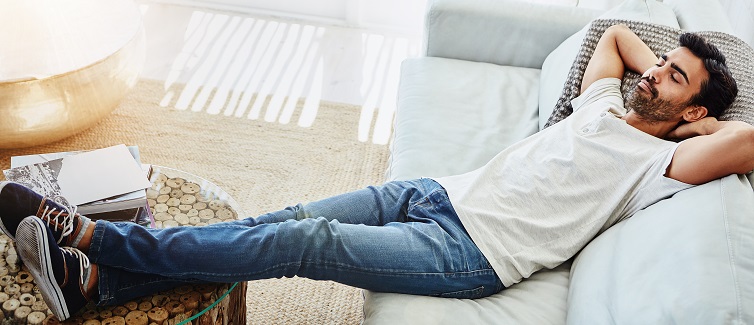It’s not uncommon to feel sluggish or tired in the afternoon. If your schedule allows for it, taking a mid-day nap is a good way to get past that slump. Done the right way, a nap can give you a boost of energy to get through the rest of your day.
While everyone naps differently, there are some things you should know to get the most from a nap.
Benefits of Naps
Naps are a great way to relax. But not all naps are an indulgence. Getting rest during the day can benefit your mental and physical health.
The benefits of napping are numerous, according to the National Sleep Foundation (NSF), and include:
- Reducing daytime drowsiness.
- Improving memory formation and cognitive performance.
- Regulating mood and emotions.
- Improving alertness and reaction time.
Many Americans don’t get enough quality sleep. Napping is also a useful tool to make up some of your sleep deficit.
Even athletes can benefit from napping. Many include napping as part of their training. A systematic review published in Nature of Science and Sleep found that napping between 20 and 90 minutes helps athletes:
- Improve physical performance.
- Improve cognitive performance.
- Boost psychological health and mood.
- Recuperate from fatigue and muscle soreness.
- Recover from sleepiness when sleep-deprived.
Never Miss a Beat!
Subscribe to Our HealthBeat Newsletter!
Thank you for subscribing!
You can now select the specific newsletters you'd like to receive.
You are already subscribed.
Subscribe to more newsletters in our email preference center.
Sorry, an error occurred. Please try again later.
Get Healthy Tips Sent to Your Phone!
How Long Should I Nap?
While athletes can benefit from naps as long as 90 minutes, most people get more benefits from shorter naps.
How Long Should I Nap to Feel Energized?
Most people only need a 20-minute nap to feel refreshed and energized, according to the NSF. This type of short nap is a power nap.
Your ideal nap time can be slightly longer. Take a few test naps of 20 minutes, 30 minutes, and 45 minutes. Notice how you feel after each to find the nap time that works best for you.
Can I Nap for Too Long?
When you take a nap, you should wake up feeling refreshed and energized. But that’s not always the case.
If you wake up from a nap feeling sluggish or tired, that means you’ve napped for too long. If you are groggy for more than an hour after waking, you are experiencing sleep inertia.
To avoid sleep inertia, set a timer for 20 minutes — or the time that matches your ideal nap time.
While naps are beneficial, it’s important to first focus on quality nighttime sleep. Mid-day naps lasting an hour or longer can be a sign that you aren’t getting enough quality sleep at night, according to the NSF. In older adults, naps lasting an hour or longer are linked to an increased risk of diabetes, depression, and heart disease.
When Should I Nap?
Along with knowing how long you should take a nap is learning when to take one. In general, you should nap during the daytime.
- The NSF recommends a nap time around halfway between the time you normally wake up and go to bed.
- For getting shut eye in the afternoon, nap between 1 p.m. and 4 p.m. Athletes who napped during this timeframe had the best results in terms of performance, according to a Nature of Science and Sleep study.
- Avoid taking a nap after 5 p.m. Taking a late nap can interfere with your normal nighttime sleep schedule. It can also contribute to insomnia because it makes it harder for you to fall asleep and stay asleep.
When you start your nap depends on your bedtime. If you do nighttime shift work, you’ll have to adjust the rules to your schedule.
Don’t limit your napping to weekends. Getting in a power nap at work can boost your alertness, mood, and memory.
Many employers encourage naps at work to boost productivity and overall well-being. An NSF survey found an estimated 34% of U.S. companies allow naps.
Napping Tips
A nap is only as good as your preparation for it. Follow these tips to get in a good mid-day nap:
- Set a timer so you don’t oversleep.
- Find a comfortable location, such as a soft chair or sofa.
- Create a nap-friendly environment. A quiet, cool, and dark room can help you fall asleep faster.
- Turn off electronic devices to avoid disrupting your nap.
- Try relaxation techniques, such as deep breathing or mindfulness meditation, before napping.
- Reduce your nap time or limit how often you nap if you notice you’re having insomnia. Some people with insomnia find any amount of napping makes it worse.
Sources
Michelle Lastella. To Nap or Not to Nap? A Systematic Review Evaluating Napping Behavior in Athletes and the Impact on Various Measures of Athletic Performance. Nature of Science and Sleep. 2021. Link.
Allyson Hoffman. Sleep Pods, Nap Rooms, and More: Companies that are Pro Nap. February 24, 2021. Sleep.org. Link.
About UPMC
Headquartered in Pittsburgh, UPMC is a world-renowned health care provider and insurer. We operate 40 hospitals and 800 doctors’ offices and outpatient centers, with locations throughout Pennsylvania, Maryland, New York, West Virginia, and internationally. We employ 4,900 physicians, and we are leaders in clinical care, groundbreaking research, and treatment breakthroughs. U.S. News & World Report consistently ranks UPMC Presbyterian Shadyside as one of the nation’s best hospitals in many specialties and ranks UPMC Children’s Hospital of Pittsburgh on its Honor Roll of America’s Best Children’s Hospitals. We are dedicated to providing Life Changing Medicine to our communities.
